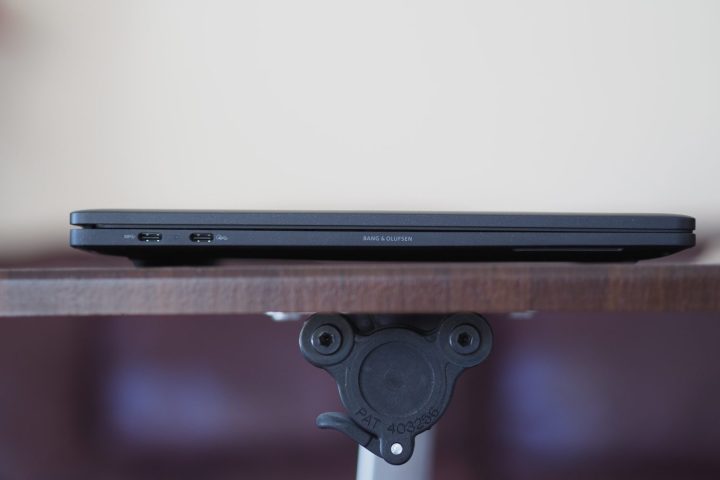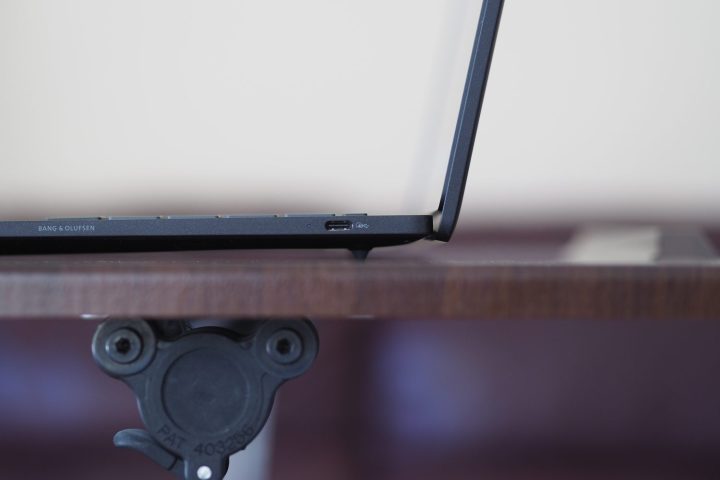“The HP Dragonfly Pro has some compromises, but makes up for with great performance and battery life.”
- Superior productivity performance
- Outstanding battery life
- Excellent keyboard and haptic touchpad
- Solid build quality
- Attractive aesthetic
- 24/7 live support
- Display could be sharper and faster
- Slightly expensive
- No legacy ports or audio jack
- A bit thick and heavy
HP expanded its quasi-commercial Dragonfly line to the Dragonfly Pro, coming in both Windows and ChromeOS versions. I say “quasi-commercial” because the line straddles the fence between consumers, small business users, and enterprises. We already reviewed the Dragonfly Pro Chromebook and found it to be one of the best on its platform, and now we’ll see if the Windows version can match it.
In short, the Windows 11-based Dragonfly Pro is also a very strong laptop, with excellent speed, tremendous battery life, and a great build. It’s not without a couple of shortcomings though, for this price, that might make you think twice about it.
Specs and configurations
| HP Dragonfly Pro | |
| Dimensions | 12.39 inches x 8.7 inches x 0.70 inches |
| Weight | 3.53 pounds |
| Processor | AMD Ryzen 7 7736U |
| Graphics | Radeon graphics |
| RAM | 16GB LPDDR5 32GB LPDDR5 |
| Display | 14.0-inch 16:10 Full HD+ (1920 x 1200) IPS, 60Hz |
| Storage | 512GB PCIe SSD 1TB PCIe SSD |
| Touch | Yes |
| Ports | 2 x USB-C with Thunderbolt 4 1 x USB-C 3.2 Gen 2 |
| Wireless | Wi-Fi 6E and Bluetooth 5.2 |
| Webcam | 5MP with infrared camera for Windows 11 Hello |
| Operating system | Windows 11 |
| Battery | 66 watt-hours |
| Price | $1,400+ |
The Dragonfly Pro comes in two configurations, both utilizing the AMD Ryzen 7 7736U CPU and a 14.0-inch 16:10 Full HD+ IPS display. With 16GB of RAM and a 512GB SSD, the laptop costs $1,400. Bump up to 32GB of RAM and a 1TB SSD, and you’ll spend $1,550. Those are reasonable prices for an extremely well-built premium laptop with solid components. Note that the laptop is available in black or white color schemes.
A truly modern design
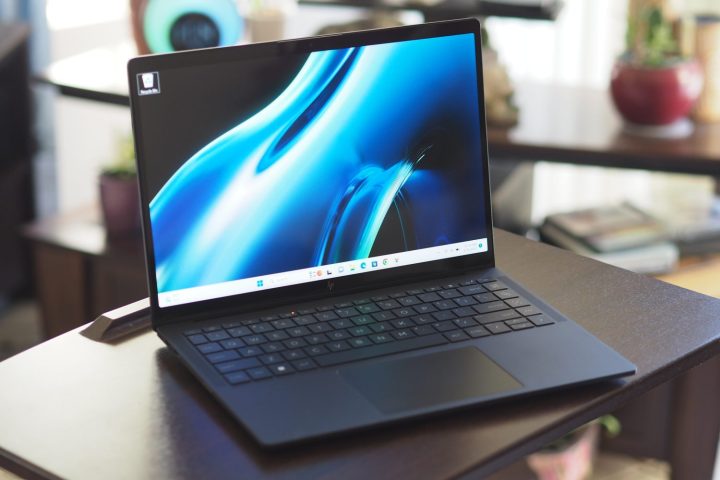
The Dragonfly Pro builds on the design aesthetic that has defined the Dragonfly line from the beginning. That is, it sports simple lines and subtle accents that create an attractive and elegant design without any augmentation. You can choose between Sparkling Black and Ceramic White, and in both cases, the keyboards match the color scheme. Other than speaker grills on each side of the keyboard and a chrome HP logo on the lid, we’re talking strict minimalism here and it works well.
HP paid some attention to sustainability in building the Dragonfly Pro, with 35% post-consumer recycled (PCR) plastic in the display bezel, 50% PCR in the keycaps, and 50% PCR in the speaker box. The keyboard frame is made up of 90% reclaimed aluminum, the outer display surface is 50% reclaimed aluminum, and the base is 90% reclaimed aluminum.
You wouldn’t be able to tell from handling the laptop, though, as it has zero bending, flexing, or twisting in the lid, keyboard deck, or chassis bottom. It’s as solid as any other premium laptop, matching the Dell XPS 13 Plus and the Apple MacBook Air M2 for rigidity. In fact, it beats out the latter, which has a lid that’s slightly bendable. Like those laptops, the Dragonfly Pro’s hinge opens with one hand and holds the lid firmly in place, adding to the feeling of elegant quality.
The Dragonfly Pro isn’t the smallest 14-inch laptop around, due in part to display bezels that aren’t as small on top and bottom as some competitors. Even so, it’s nicely sized, even if not the thinnest at 0.70 inches nor the lightest at 3.53 pounds. It has the heft of a Pro-level device with powerful graphics, even though this is limited to just integrated graphics (more on that later).
As a point of comparison, the Lenovo Slim 9i comes with a glass cover on the lid that is thinner at 0.59 inches and lighter at 3.02 pounds. That being said, the Dragonfly Pro doesn’t feel overly chunky or outdated thanks to the modern aesthetics.

The keyboard has very large keycaps and a nice layout, with some extra function keys along the side for accessing various functions within the MyHP app. The keyboard switches are quiet and snappy, with a comfortable bottoming action. I wish they were a tiny bit stiffer, though, which would make them just as good as the keyboards on HP’s Spectre line.
The touchpad is a haptic version, and it works splendidly. As usual, you can click on the entire surface with a firm haptic response that mimics physical buttons but is a lot quieter, and the touchpad was incredibly precise. It was also large, making it as good a touchpad as you’ll find on a 14-inch Windows laptop. Apple’s Force Touch haptic touchpad is still better, but not by a lot.
Connectivity is all-in on USB-C, two with Thunderbolt 4. There are no legacy ports nor a 3.5mm audio jack, both of which I miss. Wireless is Wi-Fi 6E and Bluetooth 5.2, so nothing to complain about there.
HP also integrated its human presence detection technology into the Dragonfly Pro. When configured in Windows Settings, the Dragonfly Pro will go to sleep when the user walks away and wake back up and log in when the user returns. It works well and is becoming a more common feature on modern laptops.
Easy access to 24/7 support
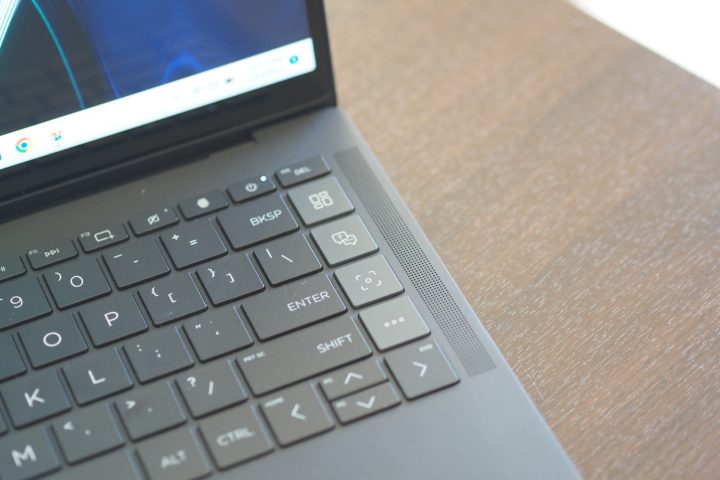
Hit one button on the keyboard, and you’re transported to the MyHP app’s Live Support section. From here, you can speak or chat with a live representative, 24/7. The rep will already know who you are and what laptop you’re working on, and you can immediately without zero fuss get started on troubleshooting a problem or uncovering a feature.
It’s an outstanding service for anyone who doesn’t have the time or the IT staff to get instant assistance in resolving problems, and it’s free for the first year. After that, you can purchase extended support, along with accidental damage protection, for $11 a month for up to 36 months.
I ran a quick test of the service by first logging into my HP account — yes, that’s a requirement — and then selecting the chat feature. I was quickly connected to an agent, where I asked a simple setup question. The agent responded quickly and accurately, and I was back on my way within a few minutes.
For more in-depth problems, the agent can remote into the laptop to help resolve issues and perform all the usual technical support functions. It’s a quick and easy way to get the Dragonfly Pro working should something go wrong.
AMD’s latest is a solid performer

HP chose AMD’s Ryzen 7 7736U CPU for the Dragonfly Pro, an eight-core/16-thread processor running at between 15 and 28 watts with a max Boost Clock of 4.7GHz. It’s a member of the latest generation of AMD’s Ryzen chips, and it performed well against Intel’s 12th-gen and 13th-gen CPUs.
At least in multi-core and CPU-intensive performance, the Dragonfly Pro dominated our comparison group. We don’t have many 13th-gen Intel machines to compare, but the HP beat the Samsung Galaxy Book3 Pro 360 running Intel’s Core i7-1360P, a 28-watt CPU with 12 cores (four Performance and eight Efficient), 16-thread CPU running at a max Turbo Frequency of 5.0GHz.
While the Intel chip was faster in single-core tests, the AMD led in almost every multi-core test I ran. It was particularly fast in the Cinebench R23 multi-core test. The Dragonfly Pro also dominated in the PCMark 10 Applications test and in our Handbrake test that encodes a 420MB video as H.265. It was also faster than the M2 CPU in Apple’s MacBook Air M2.
Interestingly, HP omitted its usual HP Command Center utility that allows adjusting the thermal performance of the laptop between quiet, normal, and performance modes. The company relies instead on AMD’s Platform Management Framework (PMF) that adjusts performance, thermals, and acoustics for the task at hand. Presumably, the harder you work the machine, the faster things will ramp up and the louder and hotter it will run.
I found this true, with the fans spinning up during my benchmarking with the machine remaining cool and quiet during normal use. HP has automatic tech like that as an option in many of its recent Intel laptops, but in this case, it relied upon the feature entirely. And it provided statistics showing the Dragonfly Pro to run significantly cooler for the user than the Dell XPS 13 Plus, which is definitely a laptop that can be a bit warm during use.
Overall, the Dragonfly Pro is an incredibly speedy productivity workstation. With just AMD Radeon graphics on board, it won’t do that well in creative tasks that can use the GPU. But any application that’s CPU-intensive will run fast on this laptop. Note that the Radeon graphics scored 2,463 in the 3DMark Time Spy test, which is better than Intel Iris Xe graphics but less than half of what you’d expect from a contemporary entry-level discrete GPU like the Nvidia GeForce RTX 4050. So, gaming won’t be a strength.
| Geekbench (single / multi) |
Handbrake (seconds) |
Cinebench R23 (single / multi) |
PCMark 10 Complete |
|
| HP Dragonfly Pro (AMD Ryzen 7 7736U) |
Bal: 1,473 / 9,061 Perf: N/A |
Bal: 84 Perf: N/A |
Bal: 1,530 / 11,158 Perf: N/A |
6,509 |
| Dell XPS 13 Plus (Core i7-1280P) |
Bal: 1,316 / 8,207 Perf: N/A |
Bal: 170 Perf: 94 |
Bal: 1,311 / 6,308 Perf: 1,650 / 7,530 |
4,309 |
| Asus ZenBook S 13 Flip (Core i7-1260P) |
Bal: 1,602 / 8,559 Perf: 1,639 / 8,923 |
Bal: 132 Perf: 117 |
Bal: 1,583 / 7,595 Perf: 1,614 / 9,220 |
5,548 |
| Samsung Galaxy Book3 Pro 360 (Core i7-1360P) |
Bal: 1,800 / 8,960 Perf: 1,781 / 9,071 |
Bal: 109 Perf: 99 |
Bal: 1,711 / 8,389 Perf: 1,750 / 9182 |
5,857 |
| Apple MacBook Air M2 (M2) |
Bal: 1,925 / 8,973 Perf: N/A |
Bal: 151 Perf: N/A |
Bal: 1,600 / 7,938 Perf: N/A |
N/A |
The Dragonfly Pro has a 66-watt-hour battery and a Full HD+ display. AMD chips are usually quite efficient, so I was hopeful for solid battery life.
What I got was even better than I expected, with the Dragonfly Pro lasting around 14.75 hours in our web browsing test, which is well above average, and 16 hours in our video looping test. In the PCMark 10 Applications test that’s the best indication of light productivity longevity, the Dragonfly Pro achieved one of the highest scores in our database at 16.5 hours.
That’s impressive battery life, no doubt aided by the lower-resolution display and AMD chipset, and it promises all-day battery life. It’s also the only laptop in our comparison group that gives the MacBook Air M2 a run for its money.
| Web browsing | Video | PCMark 10 Applications | |
| HP Dragonfly Pro (AMD Ryzen 7 7736U) |
14 hours, 40 minutes | 15 hours, 57 minutes | 16 hours, 31 minutes |
| Dell XPS 13 Plus (Core i7-1280P) |
8 hours, 0 minutes | 9 hours, 20 minutes | 6 hours, 52 minutes |
| Asus ZenBook S 13 Flip (Core i7-1260P) |
8 hours, 38 minutes | 13 hours, 16 minutes | 11 hours, 18 minutes |
| Samsung Galaxy Book3 Pro 360 (Core i7-1360P) |
12 hours, 57 minutes | N/A | 12 hours, 21 minutes |
| Apple MacBook Air M2 (Apple M2) |
17 hours, 59 minutes | 21 hours, 9 minutes | N/A |
A disappointing display
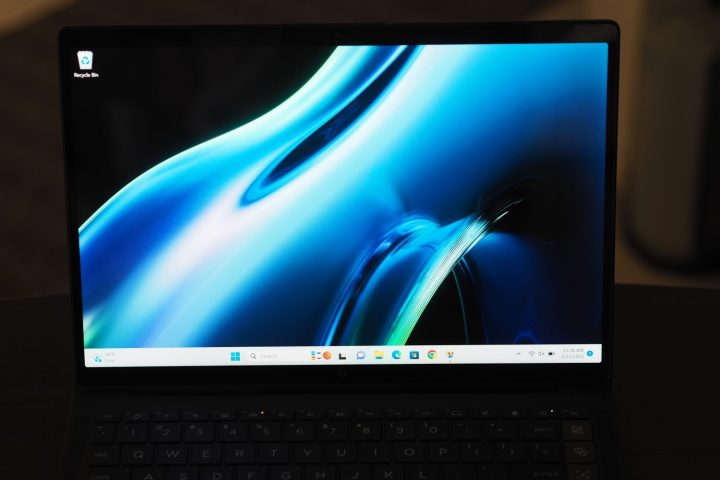
The one complaint I have with the Dragonfly Pro is its display. Most premium laptops offer at least the option of a higher resolution than Full HD+, which comes out to 1920 x 1200 at the display’s 16:10 aspect ratio. To my eyes, that’s barely sharp enough for a 14-inch display, and anyone who likes the sharpest text won’t be excited about the resolution. It’s also running at just 60Hz when more premium machines are offering 120Hz and faster refresh rates. It looks like a nice enough display out of the box, but it’s a bit of a letdown. Consider that the Dragonfly Pro Chromebook enjoys a 14-inch QHD+ (2560 x 1600) display.
According to my colorimeter, at least HP chose a quality panel. Colors were slightly wider than the premium average at 100% of sRGB and 82% of AdobeRGB (most IPS displays come in at around 75% of the latter), and they were accurate at a DeltaE of 1.03 (1.0 or less is considered professional-level). Brightness was more than sufficient at 416 nits, and the contrast was excellent at 1690:1. That’s high for an IPS panel, although of course nowhere near OLED levels.
The display will work fine for productivity users who aren’t worried about the ultimate in sharpness, and the colors are good enough for non-demanding creative types. It’s an okay display, but at these prices, I don’t understand why HP didn’t offer a higher-resolution option.
Four speakers, two along the sides of the keyboard and two downward-firing, provide just enough volume without distorting. It’s not the loudest audio system on a laptop, but its clear mids and highs and touch of bass provide a pleasant experience for streaming video and music. If you want to bump up another notch then you’ll want to use some headphones or external speakers, but most users will be fine with the built-in audio.
There’s a lot to like here
The Dragonfly Pro is really fast, gets excellent battery life, and is built incredibly well. You get 24/7 live support to keep you running, and you’ll enjoy the keyboard, haptic touchpad, and an overall cohesive design.
There are only a couple of things holding the Dragonfly Pro back from a higher score. First, there’s the display. It’s not a bad panel, it’s just not high enough resolution to compete with other premium laptops in this price range. It’s a mystery why HP decided not to offer a better display. It’s also a bit bulky for a laptop without discrete graphics, not to mention the limited port selection will turn some off. Still, the HP Dragonfly Pro is a strong debut for this new design, and a solid choice for a 14-inch laptop.


